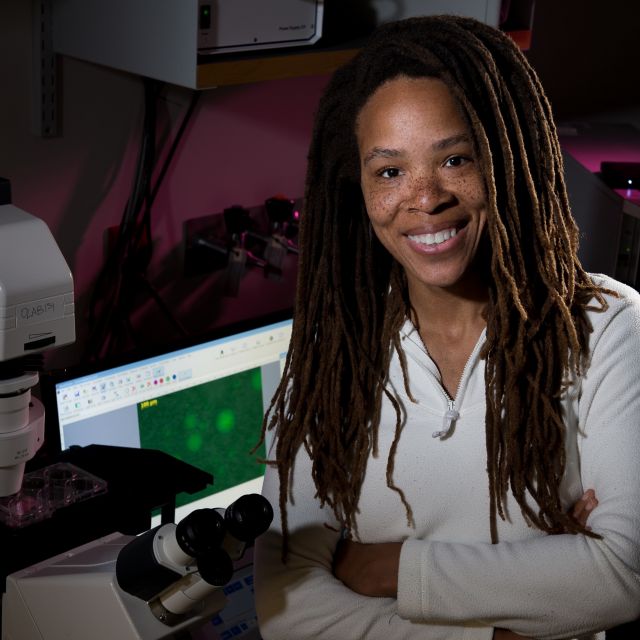
Ronke Olabisi
Building a better dressing
Despite their potential, mesenchymal stem cell (MSC) therapy has not lived up to its promise and remains an experimental approach for when classical therapies fail. This is likely due to the fact that most transplanted MSCs apoptose shortly following transplantation. It is thought that the transition from a 21% O2 culture environment to the 1-3% O2 transplantation environment is responsible, evidenced by improved MSC survival following hypoxic preconditioning, which activates the PI3K-Akt pathway. Insulin also activates the PI3K-Akt pathway, and our prior work demonstrated improved viability and function of both MSCs and insulin secreting cells (ISCs) when coencapsulated. When we coencapsulated MSCs and ISCs within hydrogel sheets and applied these as a dressing to slow-healing diabetic murine wounds, we demonstrated a paracrine therapeutic effect of the combined ISCs and MSCs, which initiated a synergistic wound healing response that rapidly closes wounds (from 40 to 14 days), and eliminates scar. We recently achieved similarly rapid accelerated healing and infection mitigation in porcine burns and have used the findings to develop biomaterial approaches towards achieving the same wound healing results.
Biography: Ronke Olabisi joined the UCI Biomedical Engineering department in 2020 and is an affiliate faculty of the UCI Sue & Bill Gross Stem Cell Research Center. Olabisi came from Rutgers University where she was an assistant professor in Biomedical Engineering with an affiliation with the Institute of Advanced Materials, Devices, and Nanotechnology. The focus of her lab is tissue engineering and regenerative medicine, with a particular emphasis on combining synthetic materials with cues from nature. By modifying synthetic materials with the natural, from small molecules, to large proteins, to cells, her lab develops cell-responsive materials. Specifically, her research has resulted in advances in wound healing, methods to form bone, and discoveries in retinal and neural tissue engineering. In addition to biomedical research, Olabisi conducts research aimed to increase the recruitment and persistence of minoritized groups in STEM. For this research, Olabisi is the recipient of a 2016 Engineering Information Foundation Award, a 2018 NSF CAREER Award, a 2019 Johnson & Johnson Women in Science, Technology, Engineering, Mathematics, Manufacturing, and Design (WiSTEM2D) Scholar Award, a 2019 Biomedical Engineering Society’s (BMES) Young Innovator in Cellular and Molecular Bioengineering Award, a 2022 BMES Diversity Lecture Award, and a 2022 NSF Workshop Award. She is a member of 100 Year Starship, an interdisciplinary DARPA-funded initiative that seeks to replicate the rapid technological development stimulated by the moon landings by imagining human interstellar travel. Olabisi earned her bachelor’s degree in mechanical engineering from MIT; two master’s degrees in mechanical engineering and in aeronautical engineering from the University of Michigan—Ann Arbor; and her doctoral degree in biomedical engineering from the University of Wisconsin—Madison. She completed postdoctoral research in biophysics with the DeStasio lab at UW-Madison, in bioengineering with the West lab while it was at Rice University, and in molecular medicine at the Berlin lab City of Hope.